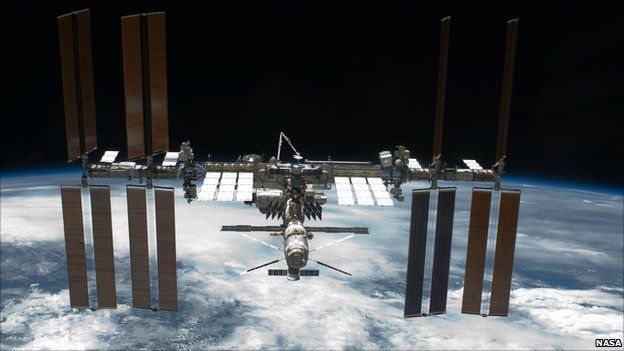International Space Station in debris scare
- Published

A piece of debris has narrowly missed the International Space Station (ISS), forcing its six crew members to go to their escape capsules and prepare for an emergency evacuation back to Earth.
Officials said the debris came within 335m (1,100ft) of the platform.
The crew were given the all clear to return to work minutes after the object passed by at 1208 GMT.
The junk was of unknown size but experts say even a small object could do considerable damage to the ISS.
The US space agency's (Nasa) Associate Administrator for Space Operations, Bill Gerstenmaier, said it was the closest a debris object had ever come to the station. An analysis was now under way to try to understand its origin, he added.
"We don't know what it was. It doesn't have an ID; it's just listed in our tables as 'unknown'," he told reporters.
The Russian space agency had earlier explained: "A situation arose linked to unidentified 'space trash' passing very close to the space station. The crew was told to take their places aboard the Soyuz spacecraft."
Soyuz capsules are used to ferry crew to and from the orbiting platform, and enough vehicles are always present so that they can be used as "lifeboats" if an emergency arises.
Before getting into the capsules, the crew closed all the hatches on the ISS.
The station is currently manned by three Russians, two Americans and a Japanese astronaut.
Dangerous fragments
A Russian official said that only 10% of all objects in Earth's orbit are satellites, while the rest is rubbish: spent rocket stages, defunct satellites, acceleration blocks and other debris.
Scientists estimate that there are hundreds of thousands of junk fragments in space of up to 10cm (four inches) in size, but there are many millions more pieces that are smaller.
Even fragments a few centimetres in width are a hazard because they travel at many thousands of kilometres per hour.
Normally, the station can use thrusters to move out of the way of a piece of junk, but this alert was raised too late for such a manoeuvre.
"We're working with our Russians partners to see if we can shorten the timeline to do manoeuvres," Mr Gerstenmaier said.
"Today, it takes us a couple of days to actually get the manoeuvre timeline loaded in station and to try to do the manoeuvre to avoid debris. We're working with Russians to make some software changes where we can do that in a much more expedient manner, so if we get late notification of another object - we'll have the ability to move."
Three crew members were forced briefly to follow the same proceedure in an incident in 2009.
The ISS is currently flying at over 380km altitude. It was pushed to this height recently to take it clear of residual air molecules at the top of the atmosphere that tend to drag it downwards over time. Station managers would not wish to push it much higher because that would take it closer to known debris fields and more of the space radiation that can be harmful to the health of astronauts.
The station is a $100bn project that has been under construction about 220m (350km) above the Earth since 1998. Five partners are involved - the US, Russia, Japan, Canada and Europe (10 nations coordinated through the European Space Agency).